|
MAIN PAGE
> Back to contents
Sociodynamics
Reference:
Roslyakova M.V.
Social networks as a tool for involving citizens in governance (using the example of the official pages of local administrations of cities in Central Russia)
// Sociodynamics.
2023. є 7.
P. 1-18.
DOI: 10.25136/2409-7144.2023.7.43708 EDN: UEIIAL URL: https://en.nbpublish.com/library_read_article.php?id=43708
Social networks as a tool for involving citizens in governance (using the example of the official pages of local administrations of cities in Central Russia)
Roslyakova Marina Valentinovna
PhD in History
Educator, Department of Management Theory, Ivanovo Branch of the Russian Presidential Academy of National Economy and Public Administration
153002, Russia, Ivanovo, Pereulok Posadsky 8

|
strateg.Obl2014@yandex.ru
|
|
 |
Other publications by this author
|
|
|
DOI: 10.25136/2409-7144.2023.7.43708
EDN: UEIIAL
Received:
03-08-2023
Published:
10-08-2023
Abstract:
Social networks are considered by the population as the leading way of communication, therefore public authorities use new technologies to inform and involve citizens in management. The purpose of the work is to evaluate the interaction of citizens and authorities using the official pages of local administrations on the VKontakte social network. The subject of the study is social networks as a tool of interaction between authorities and citizens. The article analyzes the official pages (state publications) of 7 large cities, which are the administrative centers of the subjects of the Central Federal District. Main research methods: analysis, comparison, generalization, methods of descriptive statistics. The author examines the work of Russian and foreign researchers on the problem of the use of social networks in the activities of public authorities. The indicators reflecting the effectiveness of official communities were studied: the activity of citizens on the pages, the level of involvement, the publication activity of the administration, content formats. The data was collected and processed manually and with the help of specialized services. There are few studies in which a comparative analysis of the interaction of local governments with citizens in social networks is carried out, so the article complements the current literature on digital communications in the public sector. An analysis of the indicators that characterize the activity and involvement on the official pages of local administrations shows that the practice of using social networks in the regions is different. All official pages are active, page owners (local administrations) and subscribers (citizens) are looking for ways to interact online. The results will help to identify the strengths and weaknesses of the official pages and offer recommendations for improving the participation of citizens in the management process through social networks.
Keywords:
social network, public participation, public administration, gosplik, official page, local government body, communication, like, repost, comment
This article is automatically translated.
You can find original text of the article here.
† Introduction The expansion of citizens' participation in public administration is considered as a global trend in the development of the state [8, p.79]. For modern public administration, the participation of interested groups of the population in making managerial decisions is a recognized necessity [15, p.105]. Some authors turn to the concept of "soft management" to explain the changes that are taking place, which is based on the principles of dialogue interaction and partnership [9, p.216] and is associated with multilevel management, in which horizontal rather than vertical connections between participants prevail [3]. The general approach is to use management mechanisms involving the participation of citizens and organizations in making managerial decisions [1, p.34]. In Russia, the involvement of citizens in public administration is defined as a priority direction for improving the quality of public administration (The main activities of the Government of the Russian Federation for the period up to 2024, approved. September 29, 2018). Digital transformation actualized the transition to digital technologies in the interaction of citizens (businesses) with government agencies and institutions [18, p.35]. The new generalizing concept, which is called the "digital public administration paradigm", involves the expansion of digital interaction between the state and society, including the digital participation of citizens in decision-making, the "digital binding" of citizens to state information platforms, the release of digital interaction into the space of Internet social networks [13]. The sources describe the possibilities of using digital tools to organize public participation in management: informing citizens about the actions of the authorities; clarifying the opinion of the population about the decisions taken by the authorities; involving citizens in a joint decision-making process with the authorities [19, pp.160-161]. Involving citizens in the decisionЦmaking process is a resource-intensive and expensive event, but the introduction of social media technologies contributes to fundamental changes in how civic participation takes place [21]. The social network is considered as a way of interaction, "a kind of communicative practice that realizes the need of users for free communication on the Internet" [10, p.93], we agree that "the interactivity of Internet communication allows citizens to move from the role of passive consumers of information to the role of active content creators, which provides a dialogical, debatable nature of communication" [10, p.93]. In addition to interactivity, social networks allow you to quickly distribute an unlimited amount of information with minimal costs, and use various types of content. The transformation of global social networks from a channel of everyday communication into strategic communications leads to the optimization of professional communications and is used for competition at different levels [12, pp.65-66]. There are 106 million social media users in Russia, which is 73 percent of the population (Digital 2023: The Russian Federation). The participation of Russians in social networks corresponds to the global average Ц 64 percent use social networks for communication (for comparison: in the UK Ц 76%, in Germany Ц 54%; in France Ц 42%) [17]. †81 percent of Russians visit social networks at least once a month, 71 percent Ц daily (Mediascope, 2022). A distinctive feature of the Russian Internet space is the presence of independent regional networks. The largest social network in Russia in terms of the number of users is VKontakte, 40 percent of the population uses the network daily (Mediascope, June 2023) The audience of VKontakte in Russia is 79.5 million, in the world Ц 101.7 million users per month (report vk.com , data of the IV quarter of 2022). In 2022 the rules of operation of social networks have changed, the activity of part of global networks in Russia has been discontinued. At the same time, public authorities and subordinate organizations have a legally established obligation to create official pages on VKontakte or Odnoklassniki social networks to post up-to-date and reliable information about their activities. It is obvious that the space of online network activity has been formed, as its influence expands, the assessments of this space on civic participation change, the practice of active communication of citizens on the network leads to both constructive and destructive consequences [14, p.69]. These circumstances confirm the relevance of the use of social networks in public administration. We emphasize that digital technologies can create new opportunities for dialogue between the government and society, as well as new control tools [11]. Similar risks were realized on Facebook (the network is recognized as an extremist organization and banned in the territory of the Russian Federation), in this network the principle of "openly cooperate, not manage" was changed to the opposite: "secretly manage under the guise of cooperation" [12, p.68]. Literature review Social networks are considered as an actual subject of research in the social sciences. The number of publications is increasing, while social media analytics is a separate, young field of research that does not have a single methodological approach [22, p.1064]. In Russia, the use of social networks in public administration is studied by V. V. Zotov [6, 7], including in collaboration with A.V. Gubanov [4], L. V. Vasilenko [5], in particular, it is argued that a new type of social network relations between authorities and citizens is being formed in the public space of communications, in these conditions, a new methodology of public administration is required, taking into account the digital realities of the modern world. The authors note that social networks create new opportunities for dialogue and public participation in state affairs [2]. There are few studies that consider the specifics of the interaction of local governments with the population in social networks, mainly attention is focused on the level of federal and regional authorities, the accounts of regional leaders in social networks.
Foreign studies are diverse in subject matter, we note the work of I. Mergel [29], in which the theoretical and practical issues of the use of social networks in the public sector are studied in detail. The works indicate the potential of social networks to expand civic engagement [25], it is proved that continuous monitoring, collection and analysis of social network data helps to gather valuable information for decision-making in public administration [27]. For the purposes of our work, articles by E. Bons?n, M. Ratkai are useful, who have developed a set of indicators to assess the involvement of stakeholders of a social network page [24], in the future, the author's approach is used to analyze the pages of local authorities in Western Europe [23]. Let's also pay attention to the active implementation model [28], which is used to study the activities of local authorities in the network, the heterogeneity of the practice of using social networks by municipalities is noted. It should be noted that social network analytics has the potential to identify patterns, approaches are being formed to study the interaction of authorities and the population, as well as involvement on the official pages of public authorities in social networks. In Russia, ANO "Dialog" makes a rating of official public sites, but access to it is limited, which does not allow to study the specifics of maintaining state-owned public sites by bodies and organizations. In this regard, a comparative study is relevant to identify the activity of social networks of public authorities.† The purpose of the article is to evaluate the effectiveness of interaction between citizens and local administrations using official pages on the VKontakte social network. Methods of information collection and analysis The paper considered the official pages (state-owned publications) of the executive and administrative bodies of municipalities Ц local administrations of seven cities (Vladimir, Ivanovo, Kaluga, Kostroma, Smolensk, Tver, Tula). The selected cities are the centers of regions (subjects), belong to large cities in terms of population from 250 thousand to 500 thousand, are part of the Central Federal District. The data was collected on the pages of the VKontakte network, the largest and most popular social network in Russia. Data collection and analysis in social networks was carried out in manual and automated mode using a specialized service for analyzing posts and pages in social networks. Information about subscribers and posts on the network, social network data, which are characterized as actions (activities) performed by users, including "like" (like), "share" (repost), comments, were interpreted. To assess activity and engagement on the official pages, metrics were used that characterize engagement in absolute and relative terms. Note that despite the importance and widespread use of metrics, they have certain limitations, since they cannot perfectly cover all aspects of the subject under study and simplify the processes taking place on the pages. However, using metrics allows you to evaluate the effectiveness of communication on a page, as well as compare the level of activity on different pages. The data were summarized for the month (April 1-30, 2023), except where indicated. Results and discussion In total, seven official pages (state pages) of VKontakte of seven cities were reviewed: Vladimir (https://vk.com/vladimir_adm ); Ivanovo (https://vk.com/ivgoradm37 ); Kaluga (https://vk.com/kalugagov ); Kostroma (https://vk.com/gradkostroma ); Smolensk (https://vk.com/official_smolensk ); Tver (https://vk.com/tverrussia69 ); Tula (https://vk.com/cityadmtularu ). All pages were registered before the adoption of the Law of 2022 (Federal Law No. 270-FZ of July 14, 2022 "On Amendments to the Federal Law "On Ensuring Access to Information on the Activities of State Bodies and Local Self-Government Bodies" and Article 10 of the Federal Law "On Ensuring Access to Information on the Activities of Courts in the Russian Federation""), which obliged to create official pages in social networks (Figure 1). No significant benefits from early registration of communities were found. | 2012 | 2013 | 2014 | 2015 | 2016 | 2017 |
2018 | 2019 | 2020 | 2021 | 2022 | | Kostroma | Ц | Ц | Tver | Ц | Vladimir Ivanovo | Smolensk Kaluga | Ц | Ц | Ц | Law No. 270-FZ | Figure 1 Ц The year of creation of the official pages of local administrations Confirmation of the creation of an official page on a social network by an authority or organization is the presence of a special mark assigned to the official page. This mark is issued by the social network subject to certain conditions: registration of an authority or organization in the unified identification and authentication system, as well as compliance with the requirements of the social network for obtaining a special mark. The considered official pages have a state mark ("State Organization"), i.e. the official status of the page is confirmed. This means the obligation to post up-to-date information about the activities of the authority.
Next, let's look at the number of subscribers of official accounts and compare it with the number of municipalities. The population by municipality is given as of January 1 , 2022 according to Rosstat (https://rosstat.gov.ru ). There is no direct correlation between the number of subscribers to the official pages of local administrations and the population in cities (Figure 2). †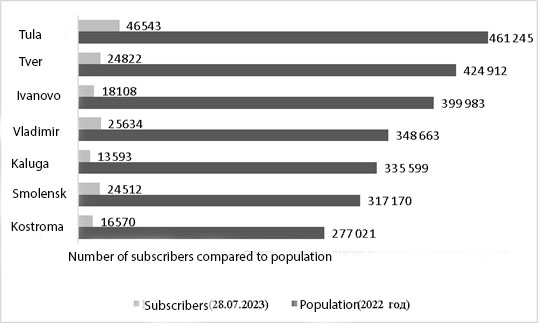 Figure 2 Ц The population of cities and the number of subscribers to the official pages of local administrations (people) Figure 3 shows the number of subscribers of the page relative to the population of the city. We agree that subscribers do not necessarily live in the city, but the general comparison by city is indicative. So, Tula has more followers on social networks than other cities Ц 10 percent, the rest managed to attract 5-7 percent of residents, Kaluga Ц 4 percent. The potential for the growth of communities exists, in the future, the accumulation of material will allow you to track the dynamics of the growth of subscribers of official communities. 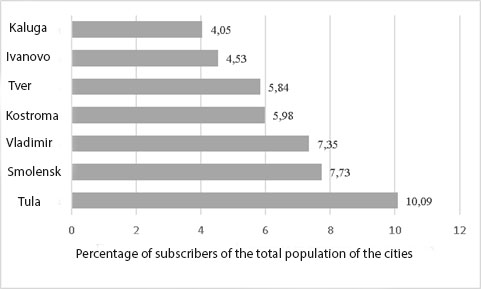 † †
Figure 3 Ц Subscribers of the official pages of local administrations (% of the population) Joining the residents of the city to the official page is important because it creates conditions for interaction with the authorities, shows the interest of the population in obtaining information through a new communication channel. However, some experts in the field of SMM believe that the number of subscribers is not an indicator of the effectiveness of the page [20]. We agree that joining the community can be formal, so you should take into account the involvement of subscribers, not the number. But we assume that there is a dependence of the activity of the administration in promoting the page and the activity of citizens in joining the community. If the administration interacts with subscribers, provides useful content, it attracts new users. We do not exclude that there are specifics of cities, for example, the local administration develops ways of communicating with residents that are different from social media channels.† Our next task is to determine the activity of the authorities in social networks. First of all, the frequency and regularity of the publication of unique content Ц posts is evaluated. The VKontakte post is text, photos, videos, infographics, cards, polls, contests, promotions, and other materials published in the community and allowing to convey information to subscribers or community members. The initial analysis shows that the official accounts are active, have relevant publications during the observation period (April-June 2023) (Figure 4).† 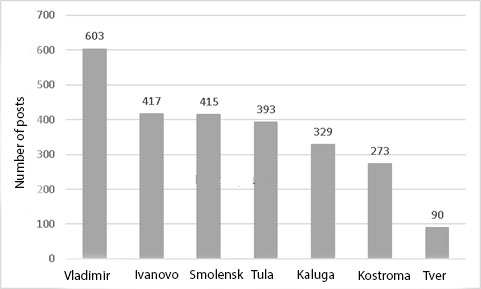
Figure 4 Ц Number of posts on the official pages of local administrations (April Ц June 2023) Note that the practice of publishing posts by local administrations differs, so the minimum and maximum number of posts for the same period of time varies significantly (90 Ц Tver, 603 Ц Vladimir). Further, the metrics that are considered in the work are summarized for the period from April 1 to April 30, 2023. A comparative assessment of communities by publication activity is presented in Table 1. Table 1 Ц Number of posts published on the official pages of local administrations (units, April 1-30, 2023) | City | Posts | Posts per day (average) | | Vladimir | 185 |
6,1 | | Ivanovo | 131 | 4,4 | | Kaluga | 121 | 4,0 | | Kostroma | 76 | 2,5 | | Smolensk | 133 | 4,4 | | Tver | 27 | 0,9 | | Tula |
118 | 3,9 | The data are representative from the point of view of the strategy of presence in social networks, the local administration of Vladimir showed the greatest publication activity (185 posts), Tver stands out for the least number of publications on the page (27), this means that the post is published on the page once a day, which differs from other state-owned publications that carry out more private publications. Vladimir, the leader in the number of posts, publishes an average of 6 posts a day. The average number of posts Ц 4 corresponds to the average number of posts for VKontakte groups of 10-20 thousand subscribers. The number of posts depends not only on the scale of the group, but also on the availability of information that needs to be conveyed to subscribers. It should be noted that it is difficult to establish an ideal level of the average daily and average monthly number of publications [30]. There are recommendations for maintaining official pages, but in the end the number of posts is determined by the body responsible for the page. For comparison: data on the publication activity of municipalities of European cities in the popular global network Facebook (recognized as an extremist organization and banned in the territory of the Russian Federation), the highest rates in Poland Ц 3.49 and Hungary Ц 2.8; the average for cities Ц 1.94 [31]. Effective communication depends on the quality of the published content. Administrations post various types of content on official pages Ц photos, text, videos and links. Table 2 shows the total number of publications with videos, images, links or text on official pages. Different types of attachments (for example, photos and videos) in one publication are counted as independent publications. Table 2 Ц Number of posts on the official pages of local administrations by type of content (units, April 1-30, 2023) | City | Photo | Text | Video | Link | | Vladimir | 127 | 185 | 61 | 59 | |
Smolensk | 121 | 133 | 13 | 6 | | Ivanovo | 114 | 131 | 14 | 41 | | Kaluga | 99 | 121 | 24 | 22 | | Tula | 89 | 118 |
22 | 40 | | Kostroma | 70 | 76 | 6 | 64 | | Tver | 16 | 27 | 10 | 9 | | Result | 636 | 791 | 150 | 241 |
Most of the publications on the page contain text that is accompanied by a photo or video. With regard to links and videos, there is a variety of practice, for example, Kostroma rarely publishes videos, and Smolensk uses links.† The share of published records by content type is shown in Figure 5. 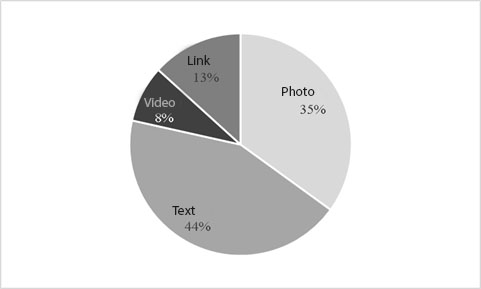
Figure 5 Ц The proportion of content types posted on the official pages of local administrations There is a dependence of user activity on the page on the type of content. The involvement in the content on the official pages is higher for videos, text, the exception is the official page of Ivanovo, where during the study period they mainly reacted to links (Table 3). Table 3 Ц Engagement rate (ERpost) by type of content posted on the official pages of local administrations | † | Tula | Tver | Smolensk | Kostroma | Kaluga | Ivanovo | Vladimir | | Link | 0,08 | 0,23 | 0,40 | 0,0892 | 0,13 |
0,235 | 0,2138 | | Photo | 0,13 | 0,28 | 0,42 | 0,0897 | 0,2 | 0,2342 | 0,1495 | | Text | 0,16 | 0,34 | 0,46 | 0,0913 | 0,22 | 0,2225 |
0,1817 | | Video | 0,33 | 0,37 | 0,89 | 0,1096 | 0,3217 | 0,1436 | 0,2525 | Publishing activity on a community page is the responsibility and initiative of the page owner, engagement means that the subscriber is active. VKontakte organizes interactive communication, interested parties have the opportunity not only to get acquainted with the messages, but also to participate in the discussion, express their attitude to the published information. Actions by which users react to social media content: like, share and comment [26]. In studies on state social networks, a distinction is made between these three functions that convey the attitude of users to content. "I like" ("like") is considered as an expression of support for published information; "share" ("repost") Ц dissemination of information that aroused interest, useful, "comment" Ц participation in a dialogue, involvement in issues. These forms of reaction in social networks are often understood as indicators of "success" or "effectiveness" [26]. Consequently, the involvement (activity) of users on social network pages is understood as quantitative indicators of such actions as likes, reposts and comments, relative to the number of participants in a particular community [16, p.32]. The data obtained show that more often the activity of citizens on official pages is manifested in "likes", less often users comment on publications and share a post. The number of activities on the official pages of local government administrations in the VKontakte network is shown in Figure 6. 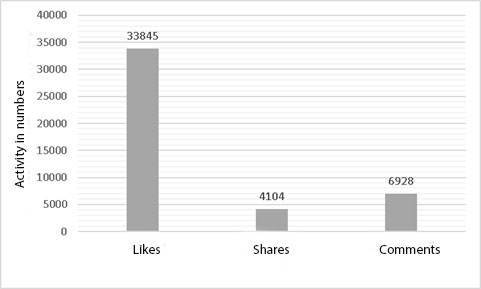
Figure 6 Ц Number of activities on the official pages of local government administrations (units, April 1-30, 2023) Table 4 summarizes the average indicators characterizing the activity of citizens on the official pages of local administrations on the VKontakte network. Table 4 Ц Average activity indicators on the official pages of local administrations (April 1-30, 2023) | City | Likes |
Shared | Comments | Views | | Kostroma | 5,97 | 1,63 | 7,53 | 1963,16 | | Kaluga | 21,23 | 2,37 | 6,76 | 2349,52 | | Ivanovo | 27,95 | 2,76 | 9,58 |
2743,78 | | Vladimir | 36,52 | 4,67 | 5,39 | 3448,11 | | Tver | 51,33 | 11,74 | 20,52 | 7035,74 | | Tula | 54,34 | 7,4 | 13,2 | 5148,03 | | Smolensk | 94,79 |
9,6 | 8,82 | 5182,65 | Average indicators are needed to compare the activity of local administrations on official pages. It is noteworthy that the number of likes does not depend on the number of subscribers and the number of publications, for example, Smolensk has fewer subscribers and posts, but more reactions from subscribers than Vladimir. Tver, receives more likes than Vladimir, who posts more often. Posts of the official Tver group are more often shared and commented on than in other cities. Ivanovo and Smolensk, having a similar number of publications, differ in the number of positive reactions (likes). We conclude that an increase in the number of posts does not increase user engagement, which is expressed in the number of likes and comments. The data obtained allow us to make two assumptions, firstly, user activity depends on the quality of content, posts should contain interesting, useful, emotionally engaging content for subscribers, and secondly, the audience reacts positively to posts and is ready to interact when it is not overloaded with information from the community. Comments as a way of responding differs from likes and reposts, it is a more complex type of interaction, reflecting the depth of involvement in the content of the post. As a positive signal for society, we note that local administrations do not close the opportunity to comment on publications and respond to comments, but the second party of communication (subscribers) does not seek to participate in an online dialogue. This feature of interaction is noted by foreign researchers, indicating that engagement decreases when participation requires great effort [21]. As an explanation, we cite the statement that "social media technologies ... are designed for emotional reactions, and not for deliberate or rationalized discussions and interactions" [26]. Summarizing the reasons for passivity in the discussion, we note, firstly, the comment requires time and effort from the user to generate independent content; secondly, the user is afraid of criticism or evaluation of other users; thirdly, the user seeks to avoid conflict situations due to the statement; fourth, the user maintains confidentiality and anonymity in the social network fifth, the content posted on the page does not stimulate or suggest discussion. When assessing the level of engagement based on indicators, it is important to take into account that comments do not necessarily mean constructive interaction and a high level of engagement, messages may be of little content, meaningless, and formal in nature. For this reason, it is necessary to study the comments from a meaningful point of view. It is important for the owners of the page to support the constructive position of the population and be sure to respond to comments on the web in order to create an environment for interaction. The paper reveals the dependence of subscribers' involvement in the discussion and topics of messages. On the page of each of the studied communities, 5 posts with the largest number of comments were selected, 35 in total, then the topic of the posts was set. The results are presented in Table 5. Table 5 Ц Topics of posts with the largest number of comments on the official pages of local administrations (April 1-30, 2023) | є | Themes | Number of posts | | 1 | Landscaping |
14 | | 2 | Road repairs | 5 | | 3 | Garbage | 5 | | 4 | Construction of schools / kindergartens | 2 | | 5 | Preparation for Victory Day | 2 | | 6 | Landscaping | 2 | | 7 | Transport | 2 | | 8 |
Courtyards | 1 | | 9 | Culture | 1 | | 10 | Meeting of fellow countrymen (SVO) | 1 | The topic of the posts shows that participation in the discussion becomes more active when questions relate to living conditions, landscaping in the broad sense of the word, attitude to the activities of the authorities for the development of the municipality. The conclusion about the influence of the topic of posts on the involvement of citizens is also made by foreign researchers, for example, attractive topics of discussion in the social networks of municipalities in Western Europe are "public transport", "housing", "public works and urban planning" [23, p.55, 59]. Thus, the discussion of local problems is an engaging information for subscribers of official communities. To assess the engagement of subscribers, ER (Engagement Rate) is used Ц the coefficient of engagement in published content (posts). Two types of ER indicators are calculated for each page: ERpost and ERday (Figure 7). For practical activities, the ERpost metric is useful, with the help of which they evaluate the popularity of publications and compare pages with each other. A high level of ER shows that subscribers actively interact with content, leave comments, likes, make reposts, and browse. According to the standard values used in marketing to assess engagement (less than 1% is a low level; from 1% to 3.5% is an average value; from 3.5% to 6% is a good level; over 6% is very good), the accounts in question are at the initial stage of subscriber engagement. Compared to the VKontakte pages, the indicators of the groups under consideration are below average (popsters.ru ) over the network, the exception is Smolensk according to the ERday indicator. 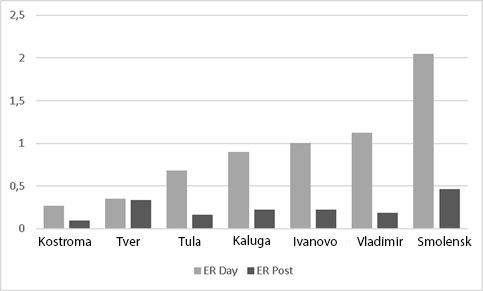
Figure 7 Ц Engagement coefficients (ERpost and ERday) on the official pages of local government administrations So, the analysis does not allow us to unequivocally state that the presence of official pages of local administrations leads to active and involved participation of citizens in governance. To objectively evaluate the effectiveness of official pages in social networks, it is necessary to accumulate data and compare pages that have similar goals and objectives. The importance of data comparison lies in the ability to reveal successful strategies and in-demand content that will help achieve the goals of the authority in the social network. However, in order to achieve the goals, it is necessary to clearly define them, taking into account the current situation of the authority and the specifics of the target audience. Conclusion In Russia, there is an obligation for authorities to interact with citizens on social networks, this is the position of the state, which seeks to involve the population in management affairs and develop feedback. Monitoring the official pages of local administrations allows you to compare the effectiveness of citizen engagement in communities, identify strategies that are used in cities, and identify best practices.
The article considered the official pages of large cities, which are the administrative centers of the regions and are part of the Central Federal District, all pages had the confirmed status of "State Organization". In general, the analysis of indicators that characterize the activity and involvement on the official pages of local administrations shows that the practice of using social networks in the regions has its own characteristics. The considered official pages are active and have relevant publications, but the publication activity of the administrations differs, the minimum and maximum number of posts for the same period of time varies (from 90 to 603 posts). Based on the data analysis, it was found that the number of subscribers to the official pages does not depend on the population of the city. An increase in the number of followers creates conditions for interaction between citizens and authorities, but the number of subscribers is not an indicator of the effectiveness of the page, it is necessary to take into account user engagement. For each page and for the sample as a whole, the types of published content and user reactions to the content were determined. The most common form of engagement (reaction) to messages is a like, less often a post is commented on or shared with other users. From the point of view of involvement, commentary is the most important tool for interaction between a citizen and a government body. The analysis of the comments showed that the discussion becomes more active when questions relate to the living conditions and improvement of the city. On average, the accounts in question are at the initial level in terms of subscriber engagement.† We assume that the owners of the page (local administrations) and subscribers (citizens) are in the process of adapting to new ways of interaction, "testing" communication channels. The results of the study, which assessed the interaction of citizens and local administrations using the official pages on the VKontakte social network, complement the existing analytics, as it contains characteristics that show the involvement and activity of state-owned websites. Page comparison allows you to identify best practices, develop recommendations to increase subscriber engagement, thereby improving strategies in managing official pages on social networks. In the future, to enrich the study, it is necessary to expand the regional sampling frame, include pages of local administrations that are created in other social networks, as well as conduct additional research involving qualitative methods, for example, surveys of users and municipal employees on problems of interaction in social networks.
References
1. Barabashev, A. G., & Utkina, V. V. (2014). On the difference between public administration analytics and public administration as a scientific direction. Public administration. Electronic Bulletin, 47, 19-38.
2. Vasilenko, L. A., Zotov, V. V., & Zakharova, S. A. (2020). Using the potential of social media in the formation of participating management. Bulletin of the Peoples' Friendship University of Russia. Series: Sociology, 20(4), 864-876.
3. Dudin M.N., Usmanov D.I., & Yurieva A.A. (2022). Application of the concept of "Soft Governance" in the implementation of flexible mechanisms for targeted assistance to the economic development of the EAEU member states. The Economy of Central Asia, 6(4), 255-270.
4. Zotov, V. V., & Gubanov, A.V. (2021). Social media as dialogue platforms for citizens and authorities of the subjects of the Central Federal District. Digital Sociology, 4(4), 28-39.
5. Zotov, V. V., & Vasilenko, L. A. (2021). The impact of digitalization on the transformation of the methodology of public administration. Management consulting, 5(149), 98-109.
6. Zotov, V. V., & Gubanov, A.V. (2022). The use of web analytics of social networks to assess the orientation of the authorities of the subject of the Russian Federation to dialogue and partnership with the citizens of the region. In Public Administration and Development of Russia: Designing the Future (pp. 68-72).
7. Zotov, V. V. (2020). Social networks as a basic element of the mechanism of public participation in public administration. Russia: Trends and Prospects of Development, 15-2, 455-458.
8. Irkhin, Yu. V. (2021). Genesis of public administration models and their modern trends and problems. In Political design in the space of social communications. Thirty Years without the USSR: Political Institutions and International Political Practices in the Post-Soviet Space (pp. 78-85).
9. Kirilyuk, O. G. (2019). Institutional reforms of public administration in the context of social changes: general trends and country features. Ostrovsky Readings, 1, 216-221.
10. Kolesnik, N. V., Kornienko, A.V., & Khosueva, S. D. (2022). Political socialization, social networks and communications: the main directions of research. Petersburg Sociology Today, 18, 86-100.
11. The concept of digital government as a political project for Russia: prospects for implementation in the context of challenges and risks of digitalization of society. (2021). Kochetkov, A. P., Vasilenko, I. A., Volodenkov, S. V., Gadzhiev, K. S., Kovalenko, V. I., Soloviev, A. I., & Kirsanova, E. G. Power, 1, 317-331.
12. Kuzheleva-Sagan, I. P. (2022). Social networks as a space for implementing strategic communications and conducting memetic wars. Communicology, 10(1), 65-79.
13. Kupryashin, G. L., & Schramm, A. E. (2021). About the prospects of the third wave of the digital public administration paradigm. Public administration. Electronic Bulletin, 84, 256-276.
14. Pyrma, R. V. (2021). "Immersion" of citizens in the digital environment of communications. Power, 1, 69-76.
15. Sungurov, A. Yu., & Dmitrieva, A. E. (2023). Public participation in government activities: public and participatory budgeting and participatory design at the level of municipalities of St. Petersburg. Issues of state and municipal administration, 2, 103-125.
16. Frolov, A. A., & Agurova, A. A. (2019). Index analysis of civic activity in social networks. News of Irkutsk State University. Series: Political Science. Religious Studies, 29, 28-43.
17. Digital Economy: 2022: a short statistical collection (2022). Abdrakhmanova, G. I., Vasilkovsky, S. A., Vishnevsky, K. O., Gokhberg, L. M., Demidkina, O. V., Demyanova, A.V., ... & Shugal, N. B. National Research. Higher School of Economics, Moscow. Higher School of Economics.
18. Digitalization of Interaction between Citizens and the state: Citizens' Assessment of effects, risks and prospects (2023). Yuzhakov, V. N., Pokida, A. N., Zybunovskaya, N. V., & Starostina, A. N. Issues of State and Municipal Management, 2, 33-73.
19. Shchur, A. L., Fedorov, A.M., & Datyev, I. O. (2019). Digitalization in state and municipal administration: world experience, problems and prospects of using online social networks. Proceedings of the Kola Scientific Center of the Russian Academy of Sciences, 10(9(9)), 158-171.
20. Effective work of the authority in social networks Unified standard of work on the Internet and methodological recommendations (2020). Competence Development Center of ANO "Dialog".
21. Alam, A., Meenar, M., Barraza, F., Khalil, M. B., & Knopp, K. (2022). Citizen engagement on local government Facebook pages: Experience from Aotearoa New Zealand. Cities, 123, 103584.
22. Zachlod, C., Samuel, O., Ochsner, A., & Werthmüller, S. (2022). Analytics of social media data–State of characteristics and application. Journal of Business Research, 144, 1064-1076.
23. Bonsón, E., Royo, S., & Ratkai, M. (2015). Citizens' engagement on local governments' Facebook sites. An empirical analysis: The impact of different media and content types in Western Europe. Government information quarterly, 32(1), 52-62.
24. Bonsón, E., & Ratkai, M. (2013). A set of metrics to assess stakeholder engagement and social legitimacy on a corporate Facebook page. Online information review, 37(5), 787-803.
25. Feeney, M. K., & Porumbescu, G. (2021). The limits of social media for public administration research and practice. Public Administration Review, 81(4), 787-792.
26. DePaula, N., & Dincelli, E. (2018). Information strategies and affective reactions: How citizens interact with government social media content. First Monday.
27. Khan, G. F. (2017). Social media for Government. Social Media for Government, 7-21.
28. Mabillard, V., & Zumofen, R. (2022). Local governments’ communication in Belgium: A focus on social media adoption. CEVIPOL Working Papers Study, 22(1), 2-43.
29. Mergel, I. (2012). Social media in the public sector: A guide to participation, collaboration and transparency in the networked world. John Wiley & Sons.
30. Zotov, V. V., & Gubanov, A. V. (2021). Interaction between public authorities and stakeholders in social media (comparative analysis of the regional practician). KnE Social Sciences, 315-322.
31. Zumofen, R., Mabillard, V., & Pasquier, M. (2022). Social media use in Central and Eastern European cities: Defining government-citizen relationships through phases. In Crises, vulnerability and resilience in public administration: the 30th NISPAcee Annual Conference. NISPAcee Press.
First Peer Review
Peer reviewers' evaluations remain confidential and are not disclosed to the public. Only external reviews, authorized for publication by the article's author(s), are made public. Typically, these final reviews are conducted after the manuscript's revision. Adhering to our double-blind review policy, the reviewer's identity is kept confidential.
The list of publisher reviewers can be found here.
The subject of the study. Based on the generated title, the article should be devoted to social networks as a tool for involving citizens in governance. The content of the article corresponds to the stated topic (the only remark is that the title says about social networks, and in the purpose and content of the article the author concentrates only on the social network Vkontakte). The research methodology is based on the study of the official pages of local administrations of cities in Central Russia. First of all, it should be noted the need to clarify the terminology: either using the established term "Central Federal District" or justifying the use of other author's terminology (this is possible, but requires justification). The relevance of the study of issues related to the use of social networks as a tool for involving citizens in management is beyond doubt, since modern trends in state and municipal management imply increased communication between public authorities and the population in order to take into account public opinion when making appropriate decisions. It seems unnecessary to duplicate the same data in tabular form and in the form of a histogram (it is recommended to leave the histogram): this problem, for example, is observed in Table 1 and Figure 2. Signed by the author, Figure 1 is essentially a table. Figures 3,4,5,6 do not have axis signatures. When finalizing the article, it is necessary to eliminate these design errors. The scientific novelty in the materials submitted for review is present and is primarily related to the results of identifying the relationship between various factors and the active involvement of citizens in government in 7 cities located in the Central Federal District. In the final part of the article, the author is recommended to describe specific areas of use of the obtained results for a potential readership (depending on the professional niche). Style, structure, content. The style of presentation is partly scientific, partly colloquial due to the increased level of freedom of its presentation (for example, "More often a post on a page is a text one that is accompanied by a photo or video"; how does this relate to the previous text? Followed by?). The structure of the article by the author is built correctly. The content of the article is prepared at a good level, but a number of points require clarification or specification. So, in particular, the article says "Comments in a positive sense are considered as the desire of users to improve the quality of life in the city, including criticizing the authorities." On the basis of what is this conclusion made? The author concludes in the final part of the main content that "We note that any metrics are imperfect, but they help to assess activity in relation to the number of subscribers, which reflects the "effective coverage" (volume of engagement) of the page." Was this the subject of the study? This is undoubtedly a limitation on the reliability of the data used. This should be mentioned in another section of the article. At the same time, within the framework of the main content, the author presents fragmentary various assessments, and what conclusions follow from this? Bibliography. The author has compiled a bibliographic list consisting of 31 titles. It is valuable that the author mainly relies on scientific publications of recent years. It is also necessary to note the uniformity of the design of the list of literature Appeals to opponents. The author reviews the sources both in the introductory part of the article and closer to the conclusion. This positively characterizes the reviewed scientific material. Conclusions, the interest of the readership. Taking into account all the above, the article requires mandatory (but small) editorial revision of the text, after which it can be published, because it will be of great interest to a wide range of people.
Second Peer Review
Peer reviewers' evaluations remain confidential and are not disclosed to the public. Only external reviews, authorized for publication by the article's author(s), are made public. Typically, these final reviews are conducted after the manuscript's revision. Adhering to our double-blind review policy, the reviewer's identity is kept confidential.
The list of publisher reviewers can be found here.
In the peerЦreviewed article "Social networks as a tool for involving citizens in government (using the example of the official pages of local administrations of Central Federal District cities)", the subject of the study is an analysis of the interaction of citizens and local administrations on the VKontakte social network. The purpose of the study is to evaluate the effectiveness of interaction between citizens and local administrations using official pages on the VKontakte social network. The work uses an approach as a methodological basis, the essence of which is the use of management mechanisms involving the participation of citizens and organizations in making managerial decisions and offering specific tools for organizing public participation in management: informing citizens about the actions of authorities; clarifying the opinion of the population about decisions taken by authorities; involving citizens in joint with authorities The authorities are developing solutions. The empirical basis of the study was the results of an analysis of the functioning of the official pages (state-owned publications) of the executive and administrative bodies of municipalities Ц local administrations of seven cities (Vladimir, Ivanovo, Kaluga, Kostroma, Smolensk, Tver, Tula). The analysis was carried out manually and automatically using a specialized analytics service for posts and pages on the VKontakte social network. To assess activity and engagement on the official pages, metrics were used that characterize engagement in absolute and relative terms. In recent years, information and telecommunication technologies have strengthened in human life, almost every family has a computer or mobile device, and the Internet has become ubiquitous and publicly accessible. The relevance of the work is due to the transformation of social media into the main channel of communication between local authorities and the population. This increases scientific interest in the problem of improving the management activities of local authorities in organizing interaction with the population in the Internet space. The scientific novelty of the reviewed work consists in the introduction into scientific circulation of new data characterizing the activities of official accounts of municipal authorities. Among them are data on the number and involvement of residents, as well as the activity of authorities on social networks. Based on data analysis, it was found that an increase in the number of followers creates conditions for interaction between citizens and local authorities, but the number of subscribers is not an indicator of the effectiveness of the page, it is necessary to take into account user engagement. At the moment, the most common form of engagement (reaction) to messages is a like, less often a post is commented on or shared with other users. From the point of view of engagement, commentary is the most important tool for interaction between a citizen and an authority. An analysis of the comments shows that the discussion is intensified when questions relate to the living conditions and landscaping of the city. This study is characterized by general consistency and literacy of presentation. The article has a good level of scientific conceptualization and a competent presentation of the results of web analytics. It will be of interest to scientists in the field of sociology of management and sociology of the city, as well as municipal employees responsible for interacting with citizens on social networks. The bibliography of the work includes 31 publications in Russian and English. There is an appeal to the main opponents from the area under consideration. Conclusion: The article "Social networks as a tool for involving citizens in management (using the example of the official pages of local administrations of the Central Federal District cities)" has scientific and theoretical significance, corresponds to the branch - sociological sciences. The work can be published.
Link to this article
You can simply select and copy link from below text field.
|
|





